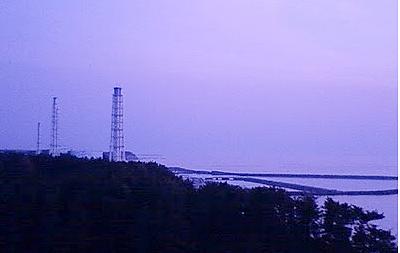‘Possible’ Partial Meltdown At Quake-Hit Japanese Nuclear Plant
TOKYO, Japan, March 13, 2011 (ENS) – A ‘possible’ partial melting of nuclear fuel rods at a nuclear power plant on Japan’s main island of Honshu occurred Sunday afternoon as workers struggled to control the overheating reactor.
At the quake-hit Fukushima Daiichi nuclear power plant on the Pacific Ocean the level of coolant water in the Unit 3 reactor dropped on Sunday, leaving the fuel rods exposed by two meters. The situation continued until 3 pm, possibly causing the fuel rods to melt.
A partial meltdown in the unit is “highly possible,” Chief Cabinet Secretary Yukio Edano told reporters. “Because it’s inside the reactor, we cannot directly check it but we are taking measures on the assumption of the possible partial meltdown.”
 |
Webcam image of the Fukushima Daiishi nuclear power plant |
As a result, masses of hydrogen gas have accumulated in inside the reactor building and the system that could relieve that pressure has failed, raising fears that the gas could cause an explosion.
“There is a high possibility that the valves in Unit 3 have failed,” said Edano. “At the present time people on the scene are doing their utmost to resolve the malfunction of the valves in order to lower the air pressure inside the reactor.”
The plant’s owner/operator Tokyo Electric Power Company, TEPCO, is “considering” ways to remove the hydrogen gas.
At the Unit 1 reactor on the Fukushima Daiichi site, workers are pumping in seawater in an effort to cool the reactor, a method approved by the Nuclear and Industrial Safety Agency. They agency says the seawater should entirely fill the reactor structure, and that the building should be safe as long as the water flow continues.
Edano said the company is mixing boric acid with the water to help absorb neutrons to slow the nuclear fission.
Readings from pressure and radiation monitors do not match data showing that nuclear fuel rods are exposed at the both reactors, possibly due to problems with the water-level gauges, an official at the nuclear safety agency said Sunday.
The official said TEPCO has been able to release pressure in the Unit 3 reactor but that he expressed concern that its fuel rods may be damaged because enough cooling water has not covered the fuel.
In Unit 3, the automatic trip of the high pressure coolant injection was “tried but failed. The reactor injection function was lost,” the nuclear safety agency said in its latest seismic damage information update at 8:30 pm Sunday local time.
Both reactors are among three that automatically shut down Friday at the Fukushima Daiishi plant when their cooling functions stopped after the area was jolted by a magnitude 8.9 earthquake.
Radiation levels outside the plant have risen. A combined 37 people have been exposed to radiation near the plant and 160 more may also have been exposed, according to the Fukushima prefectural government and the national government’s nuclear safety and disaster management agencies.
The government has expanded the evacuation zone to 20 kilometers around each of two nuclear plants – Fukushima Daiishi and Fukushima Daini – which lie 11.7 kilometers (seven miles) apart on the Pacific coast of Fukushima prefecture.
At least 80,000 people in 10 cities and towns near the nuclear plants have been ordered to evacuate. About 62,000 people are confirmed to have already evacuated.
Inadequate cooling is also occurring at the Fukushima Daini power plant, where the pumps to send seawater to cool three of its reactors have failed due to the tsunami that followed the earthquake.
TEPCO says it will try to restore the cooling systems at Fukushima Daini by replacing the pump motors overnight.
The lowest state of emergency has been declared at Japan’s Onagawa nuclear power plant, the International Atomic Energy Agency said Sunday.
The alert was declared “as a consequence of radioactivity readings exceeding allowed levels in the area surrounding the plant,” but the UN nuclear watchdog said the three reactor units at the power plant are now under control.
Two officials from the U.S. Nuclear Regulatory Commission with expertise in boiling water nuclear reactors have deployed to Japan as part of a U.S. International Agency for International Development team.
“We have some of the most expert people in this field in the world working for the NRC and we stand ready to assist in any way possible,” said NRC Chairman Gregory Jaczko.
More than 1,350 people are confirmed dead from the catastrophic earthquake and tsunami which hit northeastern Japan on Friday.
A survey by Japan Broadcasting Corporation NHK found that as of 1 pm Sunday local time, more than 310,000 people had entered evacuation facilities in six prefectures.
Miyagi police say the death toll is almost certain to exceed 10,000 in their prefecture alone.
Copyright Environment News Service (ENS) 2011. All rights reserved.
